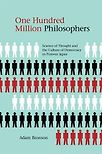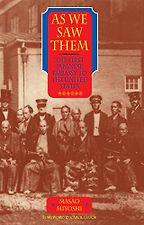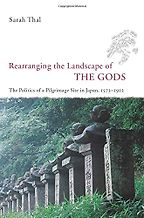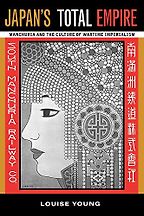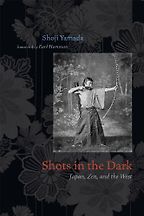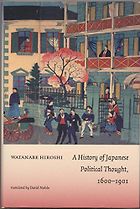Before we get on to your books on Japanese history, can you tell us a bit about how you went about choosing them and what was guiding your decisions?
It was a really difficult choice. Initially, I was going to pick the books that I personally liked the most, that I find most interesting and groundbreaking. On further reflection, I thought that those weren’t necessarily the best books to get into the subject for the first time, so I tried to think of some books that really stand on their own and represent very different approaches to Japanese history as well. I saw this as an opportunity not only to think about Japan but also about what history writing can be.
The other thing to note about the list is that I ended up picking, for the most part, books from academic presses, even though there are some really great and wonderful books that come out of trade presses. I think people might not immediately go to books that appear in academic presses but in some cases they’re really quite accessible. Part of the reason for that is that really good Japanese historians make a great effort to try to appeal to historians working in other fields. They’re writing in an open and appealing way, not at all esoteric.
The first of your books is the History of Japanese Political Thought 1600-1900 by Watanabe Hiroshi, translated by David Noble. Tell us about it.
This book is the closest one to a textbook, but Watanabe is really explicit that he’s not writing a textbook here. It’s similar to a textbook in terms of its range and breadth. But it’s also quite selective. A textbook that tried to cover the sweep of early modern into late modern Japanese history would be a book that tended to focus on what happened and why it happened. One of the things that I find really appealing about this book is the way that Watanabe looks at how things worked and what people thought about them. It was originally published in Japanese, but the translation is excellent, and the book was very much written to appeal to people who don’t have a background in Japanese history or Japanese political thought. It’s really wonderful. It tackles the early modern period, all the way across the Meiji transformation into the early twentieth century. There’s something about this book that really gets at a lot of unspoken assumptions, that tries to think about the common sense of this particular era in a way that transports you into the past.
If this book was about European political thought in the same period, there would be something covering the Reformation and the religious crisis in Europe, then the Enlightenment, the emergence of liberalism, the French Revolution, that kind of thing. What are the big themes in the history of Japanese political thought over that period? What problems were they grappling with?
One of the big things that they’re grappling with are ideas associated with Confucianism. Watanabe is really good at explaining how Confucianism can be interpreted in different ways, how it didn’t really function as a monolithic orthodoxy but could actually facilitate all kinds of debate and discovery in the early modern period. Watanabe allows you to think about ways in which this rather scholarly discourse enabled thinkers to criticise the way things worked from within and debate the implications of economic change during this period.
Did Western political thought seep into Japan over this period or not really?
Certainly, in the 19th century, thinkers were beginning to look toward important texts coming out of Europe. Translations began to appear. Watanabe handles this period well, pointing out that thinkers were inspired by new ideas that were coming in through translation. But the interpretation of these ideas, and what Japanese thinkers got out of them, often resonated with ideas and modes of thinking that spread before the onrush of new translated texts in the latter half of the century.
Let’s go to the next book, As We Saw Them: The First Japanese Embassy to the United States by Masao Miyoshi. This is a history of the 1858 Harris Treaty, I believe.
This is an account of the first-ever official delegation from Japan to the United States, in 1860, to ratify a treaty between the two countries. In some ways, it’s a micro history that really zooms into the tiny details of this trip. It’s wonderful. It’s one of the few history books that have made me laugh out loud. It is very entertaining. There’s this really dry humour throughout that comes through in the way the sources are excerpted and translated. Miyoshi’s background is in Victorian literature, he’s not somebody trained as a historian of Japan, so he approaches historical sources in a way that is wonderfully refreshing. One of the things that this book really shows you is that you can write something that’s really entertaining and accessible without necessarily adopting this mode of putting all your sources under the hood. Miyoshi brings you quite close to the sources that he’s using, he ponders over them with you. He makes some pretty speculative interpretive moves that, of course, you can disagree with, but they’re just fantastically imaginative.
“I like to ask my students why they became interested in Japan and Japanese history”
It’s a very interesting read and gives some real insight into relations between Japan and the US in the past. Miyoshi occupies a position that critically scrutinizes the different assumptions on both sides—certain racist ideas on the part of the Americans, but also certain obsessions on the part of the Japanese delegates as well. He does this by comparing how different this embassy looks when you focus on Japanese language sources—travelogues, diaries, and official reports—as opposed to the Western language sources that are coming out of the American government, but also the American press, which really treats this visit as a sensational event. On the other hand, most of the lower-ranking participants in the embassy from Japan were confined to their rooms. Their journals contain a lot of sketches of hotel sinks and hotel dressers! Miyoshi is able to weave this all together in a fascinating way.
What was at the heart of the Harris Treaty? Was it mainly about trade or did it cover other things?
The Harris Treaty opened several Japanese ports to trade. It also included the provision that Americans in Japan would be exempt from the jurisdiction of Japanese law, giving them the same kind of extraterritorial rights that the British demanded after winning the Opium War with China. That gave it the reputation of being an unequal treaty in Japan and a diplomatic coup for the United States over the British. In Miyoshi’s account, this backdrop is relevant to the carefully staged diplomatic performances on display.
Let’s go on to Rearranging the Landscape of the Gods: The Politics of a Pilgrimage Site in Japan, 1573-1912 by Sarah Thal. What does this book tell us about Japanese history?
Like Watanabe’s book, this covers a long period, spanning the early to late modern divide. It also is very tightly focused on one particular site, a sacred mountain on Shikoku, the smallest of the four major islands of the archipelago. This is a book about the history of religion in Japanese life, but rather than focus on a particular doctrine, the focus on the history of a particular site enables it to cross boundaries separating different religious traditions as well as the boundary that tends to separate histories of religion from social or economic history. This mountain becomes an important site of pilgrimage in the early modern period. An important Buddhist temple is established there, and this temple is later converted into a Shinto shrine after the Meiji Restoration in 1868.
Get the weekly Five Books newsletter
A lot of travel guides mention that contemporary Japan is a really religiously pluralistic place. People might attend a Shinto ceremony when they’re a child, and then have a Christian wedding, and then a Buddhist funeral and so forth. There’s this assumption that there’s quite a bit of religious pluralism. This book does a great job of providing some historical background to this, telling us how it actually worked and changed over time. It also provides some great insights into economic changes that took place over the early modern period, connected with pilgrimage and with different networks and local associations that sponsor people going on a pilgrimage.
This particular religious complex is associated with the protection of seafaring vessels for trade through the inland sea. It also plays an important role in mobilising people in support of Japan’s first modern war, the Sino-Japanese war of 1894-1895. So, although there’s a lot here on religion and this complex set of religious beliefs, it also provides a lot of insights into all these different aspects of Japanese society and its changing face across three-and-a-half centuries.
Next up is Japan’s Total Empire: Manchuria and the Culture of Wartime Imperialism by Louise Young.
This book is a classic. It’s launched 1,000 dissertations and monographs. There’s something about it that is unsurpassed in the way that it brings together different sides of Japan’s imperial transformation as it unfolded in the 1930s. It covers political, military and social aspects. The breadth is quite incredible.
There’s this notion that the 1930s military expansion into northeast China, into Manchuria, comes to be seen as a solution to different domestic problems in Japan—political, military, and social problems connected with class conflict. There’s a way in which Manchuria comes to appear as a kind of utopia for many different constituencies in Japanese society, for many different reasons. This book looks at the many layers of meaning that the Manchurian intervention takes on during this period.
When did the Japanese actually invade Manchuria for the first time?
In 1931 the Manchurian incident becomes the pretext for full-scale expansion into northeast China. That leads to Japan setting up a puppet state there, Manchukuo. This is outside what are considered Japan’s borders today, but Louise Young does a great job showing how it is connected to and facilitates all kinds of very important domestic changes within Japan—related to the mass media, politics, and consumerism. In many respects, these originate in the changes brought on by expansion into northeast China.
Let’s move on to Shots in the Dark: Japan, Zen, and the West by Shoji Yamada, translated by Earl Hartman
Let me just start by saying that I like to ask my students why they became interested in Japan and Japanese history. Many of them say Japanese martial arts sparked their interest, which is very relevant when we come to this book. There’s a real interest in Japan that is motivated by the notion that Japan, the martial arts, and Japanese culture more generally are potentially sources of spiritual fulfilment. What this book does, in a way I find really quite compelling, is to think carefully about how Japanese culture and the martial arts came to be associated throughout much of the world with a kind of spiritualism—in this case with Zen.
Five Books interviews are expensive to produce. If you're enjoying this interview, please support us by donating a small amount.
Basically, what Yamada is doing is trying to understand the origins of this whole genre of writing about Japan, which he sums up as ‘Zen and the Art of… [fill in the blank].’ Zen and the Art of Motorcycle Maintenance is one well-known example. He sees the origin of it in a book that appeared in the 1940s called Zen in the Art of Archery by Eugen Herrigel, a German professor obsessed with mysticism who travelled to Japan and later joined the Nazi Party.
The book is written a bit like a detective novel. Yamada peels away the layers of myth surrounding Herrigel’s experiences in Japan, in order to track down how Japanese culture came to be associated with Zen.
What period of Japanese history is he covering in this book?
There are two case studies here. The first focuses on the 20s and 30s, when the writer of this book on Japanese archery travels to Japan and later writes about his supposed spiritual experiences there. The other focuses on trying to disentangle the relationship between Zen and rock gardens after the Second World War. Again, there is this assumption that the rock garden is a spiritual place, and that spirituality is somehow connected to Zen. He really scrutinises that idea and shows how it wasn’t taken for granted until relatively recently. It’s really a mid-twentieth century phenomenon.
What exactly are we talking about when we talk about Zen? I have only a vague sense of it.
I have to admit it’s difficult for me to tackle that question as well. It’s important to disentangle the long history of Zen, a branch of Buddhism that arrives in Japan via China, from the accumulated meanings that become associated with it. There’s this assumption that Zen manifests itself in all kinds of branches of the Japanese arts but that’s somewhat separate from Zen as a religious practice that we can pin down and locate. It becomes something that supposedly infuses all kinds of different practices. I think that there is something to that but, at the same time, it really does start to take on a life of its own in the 20th century, owing to the fascination that a number of visitors from Europe and North America experience, or perhaps project upon their experiences in order to sell books!
Doesn’t it have something to do with spiritual peace or well-being or balance?
Yes, it does become associated with that. Herrigel is part of the myth-making. It’s about letting oneself go, getting outside oneself. While learning archery in Japan, Herrigel writes that he has to hit the target with his bow in the dark, but instead of shooting the arrow, he has to let the arrow shoot itself. There is this kind of subjective release, this escape from the self-governance of the self. This annihilation of the self becomes associated with Zen spiritual practice.
Interview by Benedict King
August 2, 2022. Updated: August 6, 2022
Five Books aims to keep its book recommendations and interviews up to date. If you are the interviewee and would like to update your choice of books (or even just what you say about them) please email us at [email protected]

